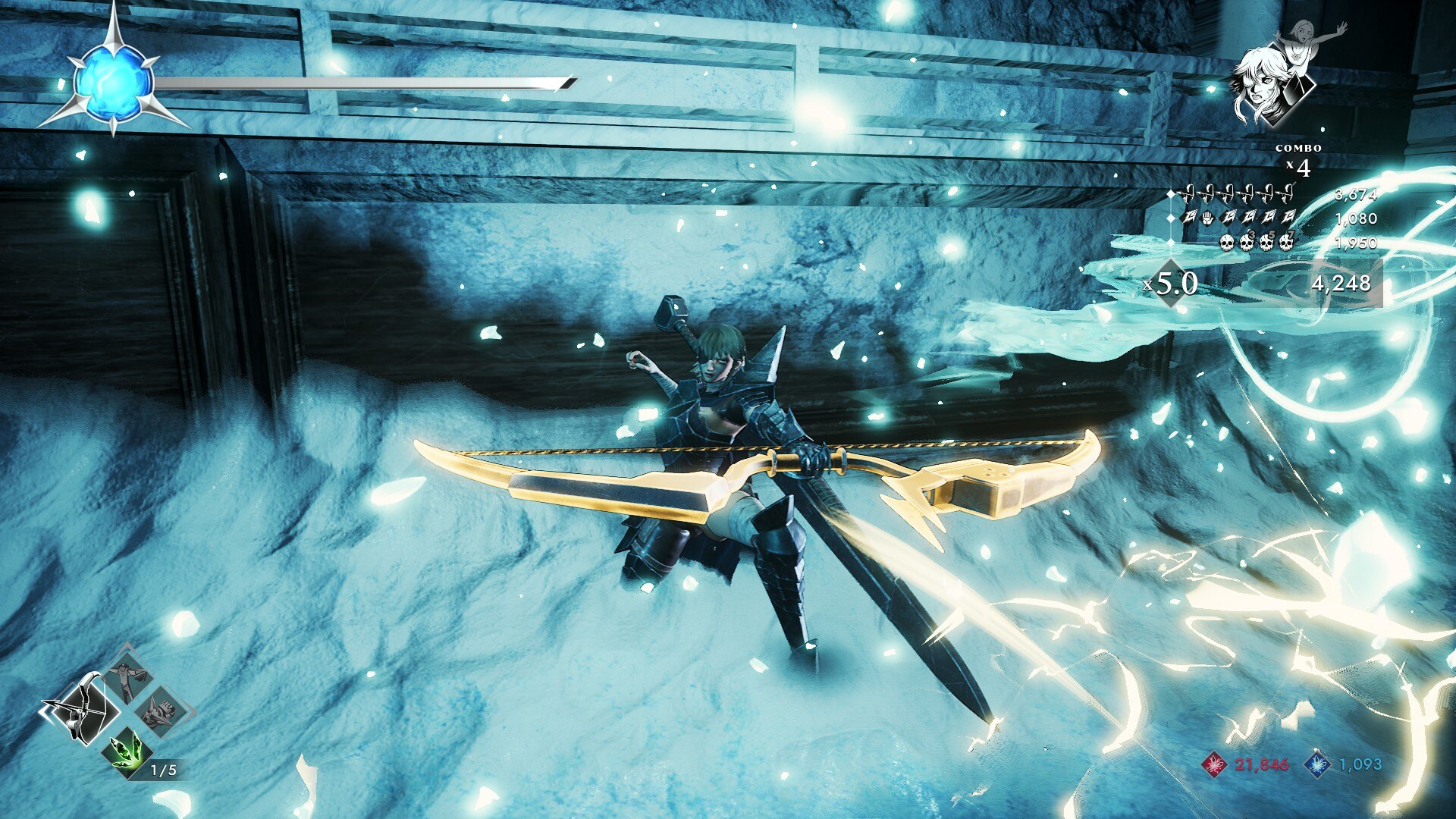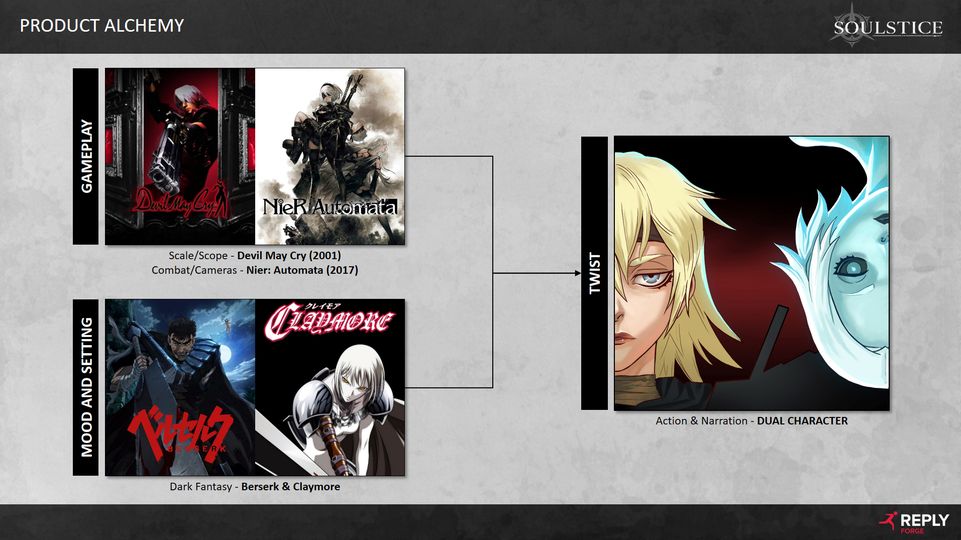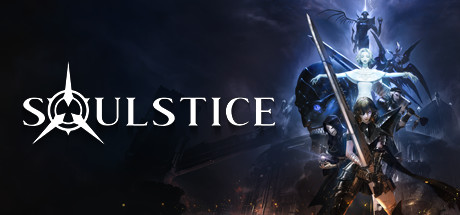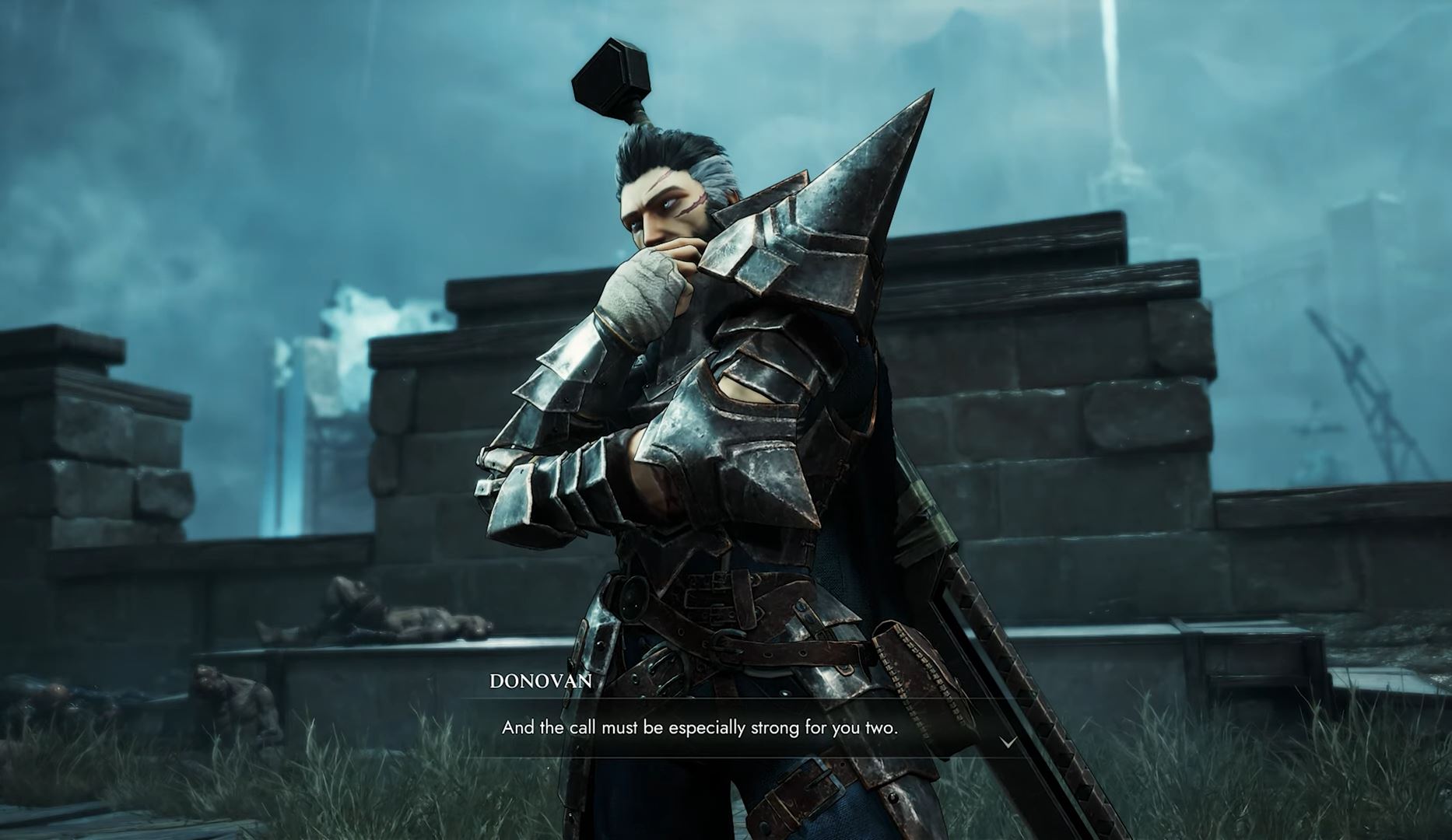Capcom and Platinumgames seem to be the center of attention on the fast-paced hack and slash 3D action games nowadays. Since Kratos took it easy on the deicide to be a dad, Bayonetta and Dante are the faces of the genre without much competition. If there’s a big fast-paced hack and slash adventure going on, it’s likely from those two companies, as also seen with Nier: Automata and DmC: Devil May Cry. They’re good at that, but sometimes I got to thinking that I wouldn’t mind someone else trying their hand at that style of gameplay for once instead of all the games taking cues from Dark Souls that keep coming up. Darksiders sure wasn’t doing it for me.
Now in 2022 Reply Games Studios has taken that crack at it with Soulstice, a fast-paced hack and slash 3D action game adventure that doesn’t even try to hide its inspirations.
This review is based on the PC version and was given to me for free.
The opening monologue explains that Soulstice’s world is one of order and chaos, where three gods created a world of order and banished the evil forces of chaos into another world beyond the veil of reality. It is a world that’s basically holding the essence of chaos back and using it to form the order-based reality it knows today, including humankind. It’s an interesting idea, but not an especially relevant one to the game for most of it.
The game proper takes place in the extravagant city of
You play as Briar and her ghost sister Lute as they are dispatched to Ilden to purge it (i.e. kill everything not human) and seal up the tear without the outside world being aware of Ilden’s fall, making it a black ops mission of sorts. Together Briar and Lute are what’s called a chimera, a special soldier of the holy peacekeepers the Ashen Knights, in which one warrior is assisted by someone’s spirit, called a shade. Briar has corruption from the chaos world within her and it’s more or less the Satsui no Hado, but Lute helps keep it in check. Chimeras have a special crystal embedded in them that binds them to their shade and gives them power, but one that uses too much of it can into a powerful monster called a transceneded, something Briar can partially utilize for a super mode.
A few other Chimeras were sent to Ilden before Briar and Lute, but apparently the higher-ups didn’t exactly make it clear how any of them were expected to seal the tear. The mystery of what those in charge are expecting is one of the big focal points of the plot. For most of the game Briar and Lute simply make their way up to the tear and try to figure things out on the way while piecing together what happened to the other chimeras as well as what happened in Briar and Lute’s own past.
I’ll get the biggest draw out of the way first: the combat is great. Calling something a wannabe carries negative connotations, but these developers appear to wear the name tag “Devil May Cry clone” as a badge of pride. Briar uses a combination of her sword and a variety of secondary weapons to hack, slash and pulverize mobs of monsters while building up a combo meter and getting graded for how good she does. Also like Devil May Cry (or at least DMC3 onward), secondary weapons are better in some situations than others. Some are good against armor, some work better for distant enemies and some have a wider arc for when too many enemies get a little too close. She can also air launch, perform quick dashes like she has Dante’s trickster style and use extra powerful, harder-hitting attacks when that combo meter is high enough. Every weapon has the same button commands, even when those commands do something a little different, meaning there isn’t as much to memorize and they’re all easy to get a handle on.
 |
| Bet I could kill Ganon with this. |
Lute acts independently from Briar, so everything you do with her doesn’t interrupt whatever Briar is doing, making Lute feel like her own separate character in the gameplay as well as the narrative and it makes the combat feel smooth and uninterrupted, as opposed to something like the Arkham games where I swear sometimes you might as well just stand there and counterattack everyone to death because you’ll you can’t get a hit in without an enemy attacking. With upgrades Lute can also provide different forms of offensive backup to add to the action, various effects to her counters and expansions to her field projections.
The whole game designs around this combat excellently from
beginning to end with a smooth, I might even say flawless, difficulty
curve. There’s always a new enemy to add
an extra challenge or a new weapon from the mission’s overseer
This is all combined with nice chunky visual and auditory feedback. The screen shakes, enemies recoil at particularly heavy hits and there’s just the right amount of hit stop and flashy displays of sparks and gore to make combat gratifying.
 |
| That one corrupted over there is just minding his own business while this is going on. |
Much like its contemporaries, the game outside of the combat almost feels like window dressing as Briar and Lute run through beautiful environments breaking objects and giant crystals for points to upgrade abilities and looking for hidden combat challenges that reward you with upgrade materials. The platforming in Soulstice is nominal, but functional and never overstays its welcome. It helps that the camera is so well positioned. When outside of combat, the camera is fixed and angles itself in a way that visually guides you in the direction you’re supposed to go as well as gives you the best view for the platforming. I wish more games used fixed camera angles as well as Soulstice does.
 |
| Not Devil May Cry. |
The story and setup of Soulstice on its own is good. The fact that this is essentially a black ops mission in what can be described as a fantastical site of nuclear fallout makes for a contained narrative in a single location, bringing to mind Mallet Island in the original Devil May Cry back when it was a modified Resident Evil setting. It turns out there’s a good reason for that too because the creative director outright shared that that very thing was part of the formula.
 |
| Of these the only one I have more than passing knowledge of is Devil May Cry. |
I like it. Not showing or interacting with the outside world directly puts you in the isolated shoes of the protagonists and makes sense from a narrative standpoint because of the secret nature of the mission. If there were too many characters to talk to the place would be a lot less dead.
Briar and Lute are an endearing pair of protagonists and other characters come out of the woodwork with their own stories and personalities. There are turns and a few twists, even though sometimes certain points aren’t made clear or are supposed to be inferred, but it’s nothing too hard to grasp and there’s an in-game codex to clarify things if you didn’t quite catch something. There seems to be a theme of characters losing themselves and living with the consequences of difficult decisions, especially with Briar’s struggles with keeping her chaos power in check in the face of escalating danger that might require it.
Apparently the story and setting takes inspiration from Berserk and Claymore, but I know little about either of those (outside of David Brimmer saying Zod’s his favorite role ever), so I couldn’t say how much of the plot is taken from those, but I do know that Soulstice tells its own story well with character development, mysteries with setup and payoff and some great sections where you view projections of the past to piece together backstory, including several in Briar’s mindscape.
Soulstice blends that story and gameplay very nicely in its boss fights. All the bosses are excellently designed in their gameplay and visual design. The Shin Megami Tensei-looking monsters you fight later are the best examples, but even the throwaway bosses that are fought once and never referenced again leave a memorable impression and slight impact on plot progression. I daresay these boss designs are even better than most of those seen in Devil May Cry. It’s great stuff.
The story isn’t the problem in Soulstice. It’s the pacing. I found that the gameplay never lost its edge
in the over a dozen hours it took to beat the game, but the story doesn’t keep up
with it. When the story gets going it
can be pretty great, but those story beats are spread out among what is usually
at least a full hour of nothing happening except a few relevant conversations plus
some optional ones with
It isn’t among the worst pacing I’ve seen in a game (Blazblue Chronophantasma and Valkyria Chronicles 2 are way worse), but it still feels like it’d be a smoother narrative if it cut about 20% of its fighting.
Even when you get to the story though, its presentation has some problems. If your computer can handle higher settings the gameplay looks great. All the character models, environments and effects have luster and detail put into them and it’s never visually boring to look at. It has a strong gothic art direction throughout. All of this is evident in playing the game, but when it’s story time, shortcomings start cropping up.
When it’s not two characters talking in static poses the story is conveyed by fully animated cutscenes that can oftentimes look amazing. There’s some surprisingly great framing, cinematography and use of slow motion combined with an already impressive art direction so clearly someone knew what they were doing, but the character animations themselves show blemishes. The characters animate just fine, but don’t really have the kind of articulation or motion capture you see in the bigger action games and interactions between them can feel off. The shots of collision and violence are particularly bad at times, looking like exactly what they are: character models colliding with each other and effects being added on. At their worst they animate like an admittedly high-grade Source Film Maker video.
Maybe that can be blamed on my not having everything at the highest graphics settings, but the animation usually lacks sufficient weight regardless of how nice the models look. Because of that the spectacle is often at its best when characters don’t have to directly touch. Also, should you play the game on PC, make sure the shadow effects are at maximum in the settings if you can help it. The use of lighting is great regardless, but if it’s below the highest setting all the shadows depict Minecraft characters, ruining cutscenes that use them for effective camera shots.
The voice acting doesn’t do it any favors, but doesn’t do it
a disservice either. Stefanie Joosten
does a good job of voicing both Briar and Lute.
Her Briar voice in particular has a distinct tone of stoicism, but
toughness in her gloomy situation without sounding bored and her Lute voice
surprisingly doesn’t sound like the same person and gets across her softer
personality very well. Everyone else
gets the job done, even if
 |
| "You got a funny accent, man. Where are you from?" |
They read their lines like they’re going through the motions, but never like they don’t care. It’s not voice acting amateur hour, but it’s not Crispin Freeman masterpiece theater either. Instead it’s amateur hour at the sound studio.
The volume noticeably drops during cutscenes and the audio
for the voices isn’t consistent, which is especially noticeable with
That said, only a few of Soulstice’s presentation issues are especially egregious and not deal-breakers, I’ve seen plenty of bigger games that have it worse and it’s possible at least some of them are the result of my upper-mid graphics settings I set the game on, of which there are a notably impressive number. All the standard options are there like shadow, model, lighting and texture quality, but there’s also the option unlock the framerate or lock it to 30 or 60 FPS, which is not as common an option in PC games as it should be.
Even more impressive is the accessibility options. For gameplay, Soulstice has options to make combat easier with various modifiers. The biggest one is an easy mode that has you choose what to attack and where and have it handle the button bashing, weapon switching and field projections. If a player would rather have it more the other way around, there’s a setting that makes Lute automatically hit every counter prompt. It’s probably a nice thing to have for players that might have a disability or condition that prevents them from playing these types of games optimally, but even for everyone else these are almost like cheats you can use without needing a code. These options plus the difficulty levels makes it so that Soulstice can be as casual or hardcore as you need it to be.
On the topic of disabilities, Soulstice also offers three different colorblind options, a larger font and a dyslexic font, which is the first time I’ve ever seen that in a game. Screen shaking that occurs during heavy hits can also be turned off for anyone who might easily get motion sickness and instances of button mashing can be simplified to a single button press, presumably for people with finger joint issues or just hate button mashing. The developers gave special attention to options that other companies gloss over and I have to commend them for that. I hope other developers take after their example, but I understand the core game is more of a priority.
In some ways Soulstice offers a more complete game than a lot of newer games that get sold for $60, which very few are actually worth. That’s why it surprised me that the developers sweetened the deal by selling Soulstice for $40. $40-$50 is the initial price of re-releases and smaller titles like Capcom’s fighting game collections or Jojo’s Bizarre Adventure: All Star Battle R, not a fully-featured action game like Soulstice. I think $50 would’ve been a reasonable price. $40 is like a permanent sale.
It couldn’t be more obvious that these developers want to make Soulstice branch off into a series. Without spoiling anything, the loose ends are very in-your-face by the time of the climax and the post-credits scene practically slams your face into those loose ends. Other games are content to have their sequel hook stingers be brief snippets or dialogue exchanges, but Soulstice takes it two steps further and practically plays a full introductory video to the possible sequel complete with character and conflict introductions.
I want to play that sequel. Soulstice is a fun, challenging, beautiful adventure that no action game player should miss. It plainly cribs ideas from across acclaimed media, some more blatantly than others, but rather than be a Frankenstein’s Monster of unoriginality, it takes those ideas and blends the best parts of them into its own story and style, resulting in something that has a bit of everything that I like: a story boxed in a lonely area to put a spotlight on the few characters there are, fun and frantic in-depth combat, striking visual designs and a story presentation that has its imperfections, but shows an attention to cinematography and takes advantage of the interactivity of games as a storytelling medium. The biggest gripe I have is the story’s pacing, and even that is offset by how good the gameplay is. With everything considered, I give Soulstice an 8 out of 10.


No comments:
Post a Comment